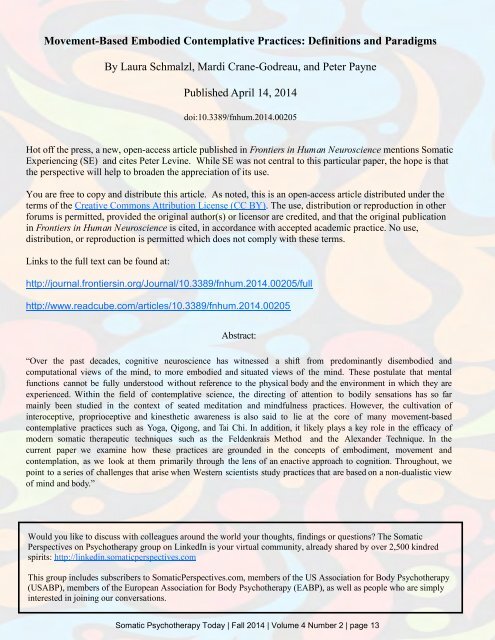SPT-Fall2014
SPT-Fall2014
SPT-Fall2014
You also want an ePaper? Increase the reach of your titles
YUMPU automatically turns print PDFs into web optimized ePapers that Google loves.
Movement-Based Embodied Contemplative Practices: Definitions and Paradigms<br />
By Laura Schmalzl, Mardi Crane-Godreau, and Peter Payne<br />
Published April 14, 2014<br />
doi:10.3389/fnhum.2014.00205<br />
Hot off the press, a new, open-access article published in Frontiers in Human Neuroscience mentions Somatic<br />
Experiencing (SE) and cites Peter Levine. While SE was not central to this particular paper, the hope is that<br />
the perspective will help to broaden the appreciation of its use.<br />
You are free to copy and distribute this article. As noted, this is an open-access article distributed under the<br />
terms of the Creative Commons Attribution License (CC BY). The use, distribution or reproduction in other<br />
forums is permitted, provided the original author(s) or licensor are credited, and that the original publication<br />
in Frontiers in Human Neuroscience is cited, in accordance with accepted academic practice. No use,<br />
distribution, or reproduction is permitted which does not comply with these terms.<br />
Links to the full text can be found at:<br />
http://journal.frontiersin.org/Journal/10.3389/fnhum.2014.00205/full<br />
http://www.readcube.com/articles/10.3389/fnhum.2014.00205<br />
Abstract:<br />
“Over the past decades, cognitive neuroscience has witnessed a shift from predominantly disembodied and<br />
computational views of the mind, to more embodied and situated vie of the mind. These postulate that mental<br />
functions cannot be fully understood reference to the physical body and the environment in which they are<br />
experienced. the field of contemplative science, the directing of attention to bodily sensations has so far<br />
mainly been studied in the context of seated meditation and mindfulness practices. However, the cultivation of<br />
interoceptive, proprioceptive and kinesthetic awareness is also said to lie at the core of many movement-based<br />
contemplative practices such as Yoga, Qigong, and Chi. In addition, it likely plays a key role in the efficacy of<br />
modern therapeutic techniques such as the Feldenkrais Method and the Alexander Technique. In the<br />
current paper we examine how these practices are grounded in the concepts embodiment, movement and<br />
contemplation, as we look at them primarily through lens of an enactive to cognition. Throughout, we<br />
point to a series of challenges that arise when Western scientists study practices that are based on a non-dualistic vie<br />
of mind and body.”<br />
Would you like to discuss with colleagues around the world your thoughts, findings or questions? The Somatic<br />
Perspectives on Psychotherapy group on LinkedIn is your virtual community, already shared by over 2,500 kindred<br />
spirits: http://linkedin.somaticperspectives.com<br />
This group includes subscribers to SomaticPerspectives.com, members of the US Association for Body Psychotherapy<br />
(USABP), members of the European Association for Body Psychotherapy (EABP), as well as people who are simply<br />
interested in joining our conversations.<br />
Somatic Psychotherapy Today | Fall 2014 | Volume 4 Number 2 | page 13


